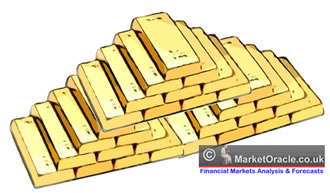The Next Financial and Economic Crisis in the Making
Stock-Markets / Stocks Bear Market Aug 20, 2009 - 01:36 AM GMT Claus Vogt writes: From time to time it’s necessary to get a bird’s-eye view of the financial markets. And given the market’s recent run-up, such a moment has arrived.
Claus Vogt writes: From time to time it’s necessary to get a bird’s-eye view of the financial markets. And given the market’s recent run-up, such a moment has arrived.
Let’s start with a review of what has happened up until now to get a better understanding of what will likely happen next …
Where It All Began …
The global real estate bubble was by far the most important influence on the economy and the financial markets during the past economic boom cycle.
Simply put, without the real estate bubble and the accompanying lending binge, there would have been no boom at all. Consequently, as soon as the bubble burst, a major recession followed and a huge credit problem emerged.
The few analysts who understood this — and the Fed’s economists weren’t among them — knew how badly it would end. But when it would happen was open to debate. Although very few expected this madness to go on as long as it did.
The Ignorance of the Economic Establishment
 |
| Easy monetary and fiscal policies started the real estate bubble … the most severe crisis since the Great Depression. |
It’s easy to understand how loose monetary policy causes inflation and/or speculative bubbles. But the economic establishment in Washington, on Wall Street, and more or less all over the world refuses to acknowledge the cause and effect relationship!
They insist on Keynesian theories of macro managing the economy mainly by monetary and fiscal policies, thereby rapidly increasing the government’s influence.
Their models and theories totally missed the importance of the real estate bubble and its aftermath … the most severe crisis since the Great Depression. And they were incapable of forecasting the meltdown of the banking system.
It should be clear that following the wrong models and theories leads to the wrong conclusions and wrong policies. And that’s exactly what’s going on today.
The policy prescriptions since this crisis erupted are the very same that laid the foundation for the real estate bubble. So the toxin that caused the crisis is being given as the antidote!
This has led to a postponement of the next stage of the current crisis. Yet if governments keep throwing trillions down these rat holes, we’ll end up with a financial and economic catastrophe much larger than the current one.
So although I suggest you take a bullish medium-term view, you should remain very bearish about the long-term. Remember …
Secular Bear Markets Consist of Cyclical Swings
I believe that the stock market and the economy entered a secular bear market in 2000 when the technology bubble burst. The first recession took place in 2001, and the first cyclical stock bear market ran from 2000 until 2002/03. That’s when governments all over the world implemented extremely easy monetary and fiscal policies.
Their strategy worked … the recession stopped in its tracks. But it came at a very high price … starting a real estate bubble. This artificial and unsound boom lasted until 2007. Then the bubble burst and all hell broke loose! And the second recession and the second cyclical stock bear market began.
Again governments stepped in, but to a much larger degree than in 2001-2004. And, for now at least, they’ve rescued the banking system by bailing out nearly all big banks and initiated a medium-term uptrend in the world’s stock markets.
The long-term analysis is simple and easy: With each round of counter crisis policy, governments are upping the ante. So each crisis is getting more expensive and more damaging than its predecessor.
The severity of the 2007/08 crisis should make it clear what an even worse version could look like: The total collapse of the banking system and of the world’s dollar-based financial system, probably including the bankruptcy of some states. Even hyperinflation seems to be a probable outcome of these policies.
 |
| Gold could help protect your wealth from the impact of hyperinflation. |
That’s why I suggest you consider adding gold and gold mining stocks to your portfolio. The strong technical picture of the precious metals sector adds to my overall bullishness, too.
Now, Another Important Question: How Long Will this Stock Rally Last?
There are so many unsolved economic and financial problems that we can categorically rule out a new long-term uptrend.
The very best outcome of the current policy is some kind of a cyclical uptrend, something like 2004-2007. The more probable outcome is a much shorter interruption of the still lingering crisis, maybe a year or so.
However, there’s no way of telling for sure how long this medium-term uptrend may last, because …
- We don’t know what policy makers will do during the coming quarters.
- We don’t know if, when or how the Fed will implement an exit strategy for its extremely easy money policy.
- We don’t know how many trillions of dollars more Washington might fork over to whoever begs for handouts.
- And we don’t know when the Treasury bond market will finally start to demand higher interest rates.
Nevertheless, a lot will depend on these developments. So we have to analyze the situation as it evolves …
That means we have to be alert for signs of renewed weakness emerging.
These may come from Fed policy, the bond market or from the huge wave of pending resets in the mortgage credit area.
The Leading Economic Indicators (LEI) might start signaling a turn in the economy’s fortune.
Or the stock market’s technical indicators could warn us about the next stock market bear phase.
 |
| Although key indicators confirm the current advance, you should remain patient and cautious before buying into the market. |
We don’t know which of these important areas will finally signal the next downleg. For now, though, most instruments point to a continuation of the uptrend that started around March 2009 …
The LEI has established a historically reliable turnaround. The Fed is talking about exit strategies … but doing nothing. And the stock market shows a text book bottoming formation with a dynamic breakout to the upside confirmed by a rising 200-day moving average.
Other important trend indicators, like the advance decline-line and the advance-decline volume line, are also confirming this medium-term advance.
What to Add and When …
As a general rule you should consider buying sectors and stocks showing relative strength — like most Asian stock markets or the technology sector. But only buy them on weakness. The Chinese stock market, which has taken an 18 percent hit during the past few days, is one such example.
You might also consider U.S. value stocks with attractive dividend payments and solid business models. But again, you want to buy these stocks on short-term weakness. So here, too, patience is necessary and solid buy and sell signals are absolutely critical.
Best wishes,
Claus
This investment news is brought to you by Money and Markets . Money and Markets is a free daily investment newsletter from Martin D. Weiss and Weiss Research analysts offering the latest investing news and financial insights for the stock market, including tips and advice on investing in gold, energy and oil. Dr. Weiss is a leader in the fields of investing, interest rates, financial safety and economic forecasting. To view archives or subscribe, visit http://www.moneyandmarkets.com .
Money and Markets Archive |
© 2005-2022 http://www.MarketOracle.co.uk - The Market Oracle is a FREE Daily Financial Markets Analysis & Forecasting online publication.



